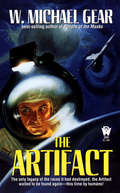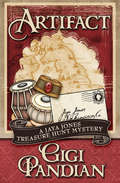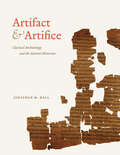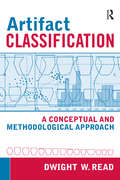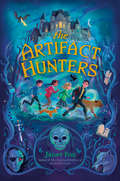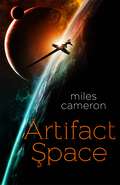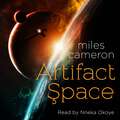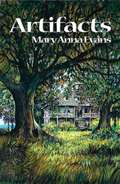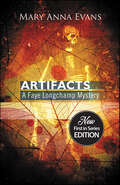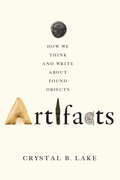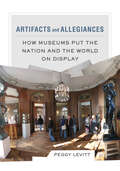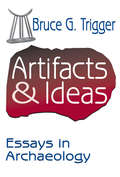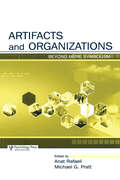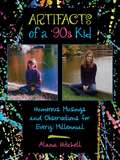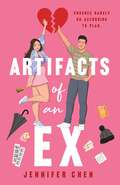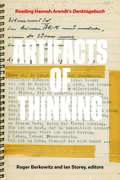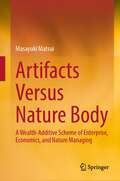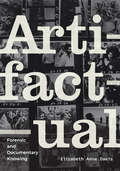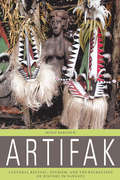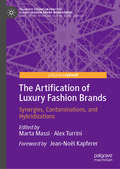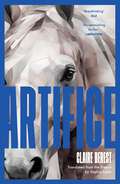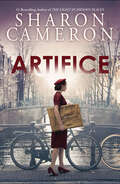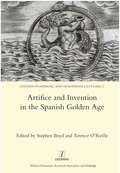- Table View
- List View
The Artifact
by W. Michael GearIn a galaxy on the brink of civil war, the Brotherhood seeks to keep peace through diplomacy, subterfuge, and control of both technological advances and the carefully gathered knowledge of countless worlds. But now Speaker Archon, formerly a privateer and currently head of the world of Star’s Rest, has brought news of a discovery that may prove a great boon to humankind or a catalyst for its destruction. The Brotherhood ship Boaz, carrying diplomats representing all the human planets, stations, and colonies, is launched on a journey to distant Star’s Rest. Only Archon and his daughter know what awaits them there. And neither they nor Captain Carrasco can anticipate the treacherous games of intrigue and betrayal about to be played out aboard Boaz. Yet the greatest danger is that they will actually survive to reach Star’s Rest and the alien Artifact. For this creation of a long-vanished civilization has been waiting patiently for millennia to lure humans to extinction....
Artifact (The Jaya Jones Treasure Hunt Mysteries #1)
by Gigi PandianYou can practically hear the Indiana Jones theme song when you crack the first page of this USA Today bestseller. The suspenseful, mysterious, and romantic come together in the exotic world of treasure hunts . . . <P><P>When historian Jaya Jones receives a mysterious package containing a jewel-encrusted artifact from India, she discovers the secrets of a lost Indian treasure may be hidden in a Scottish legend from the days of the British Raj. But she’s not the only one on the trail. <P><P>From San Francisco to the Highlands of Scotland, Jaya must evade a shadowy stalker as she follows hints from the hastily scrawled note to a remote archaeological dig. <P><P>Helping her decipher the cryptic clues are her magician best friend, a devastatingly handsome art historian with something to hide, and a charming archaeologist running for his life. <P><P>When a member of the dig’s crew is murdered, Jaya must figure out which of the scholars vying for her affections might be the love of her life—and which one is a killer.
Artifact & Artifice: Classical Archaeology and the Ancient Historian
by Jonathan M. HallIs it possible to trace the footprints of the historical Sokrates in Athens? Was there really an individual named Romulus, and if so, when did he found Rome? Is the tomb beneath the high altar of St. Peter’s Basilica home to the apostle Peter? To answer these questions, we need both dirt and words—that is, archaeology and history. Bringing the two fields into conversation, Artifact and Artifice offers an exciting excursion into the relationship between ancient history and archaeology and reveals the possibilities and limitations of using archaeological evidence in writing about the past. Jonathan M. Hall employs a series of well-known cases to investigate how historians may ignore or minimize material evidence that contributes to our knowledge of antiquity unless it correlates with information gleaned from texts. Dismantling the myth that archaeological evidence cannot impart information on its own, he illuminates the methodological and political principles at stake in using such evidence and describes how the disciplines of history and classical archaeology may be enlisted to work together. He also provides a brief sketch of how the discipline of classical archaeology evolved and considers its present and future role in historical approaches to antiquity. Written in clear prose and packed with maps, photos, and drawings, Artifact and Artifice will be an essential book for undergraduates in the humanities.
Artifact Classification: A Conceptual and Methodological Approach
by Dwight W ReadArchaeologists have been developing artifact typologies to understand cultural categories for as long as the discipline has existed. Dwight Read examines these attempts to systematize the cultural domains in premodern societies through a historical study of pottery typologies. He then offers a methodology for producing classifications that are both salient to the cultural groups that produced them and relevant for establishing cultural categories and timelines for the archaeologist attempting to understand the relationship between material culture and ideational culture of ancient societies. This volume is valuable to upper level students and professional archaeologists across the discipline.
The Artifact Hunters
by Janet FoxIsaac Wolf can travel through time. But he's also in a race against it.With tensions in Prague rising at the height of World War II, Isaac Wolf is forced to leave home with nothing more than a small backpack and a pendant in the shape of an eternity knot. His parents believe the pendant will keep him safe--if he can discover what it really means.This clue leads him to Rookskill Castle, home of the Special Alternative Intelligence Unit where gifted children can learn to harness their powers to support the Allies' cause. With the help of his new friends and an antique watch that allows him to travel through time, Isaac must unlock his own powers and uncover the true meaning of the eternity knot. The only way he can do that, though, is by hunting for a series of magical artifacts that are scattered throughout the past . . . and Isaac isn't the only artifact hunter. Soon he finds himself in a race against a threat just as deadly as the war itself--one that his parents had been trying to shield him from all along.
Artifact Space
by Miles CameronOut in the darkness of space, something is targeting the Greatships.With their vast cargo holds and a crew that could fill a city, the Greatships are the lifeblood of human occupied space, transporting an unimaginable volume - and value - of goods from City, the greatest human orbital, all the way to Tradepoint at the other, to trade for xenoglas with an unknowable alien species. It has always been Marca Nbaro's dream to achieve the near-impossible: escape her upbringing and venture into space.All it took, to make her way onto the crew of the Greatship Athens was thousands of hours in simulators, dedication, and pawning or selling every scrap of her old life in order to forge a new one. But though she's made her way onboard with faked papers, leaving her old life - and scandals - behind isn't so easy. She may have just combined all the dangers of her former life, with all the perils of the new . . .
Artifact Space
by Miles CameronOut in the darkness of space, something is targeting the Greatships.With their vast cargo holds and a crew that could fill a city, the Greatships are the lifeblood of human occupied space, transporting an unimaginable volume - and value - of goods from City, the greatest human orbital, all the way to Tradepoint at the other, to trade for xenoglas with an unknowable alien species. It has always been Marca Nbaro's dream to achieve the near-impossible: escape her upbringing and venture into space.All it took, to make her way onto the crew of the Greatship Athens was thousands of hours in simulators, dedication, and pawning or selling every scrap of her old life in order to forge a new one. But though she's made her way onboard with faked papers, leaving her old life - and scandals - behind isn't so easy. She may have just combined all the dangers of her former life, with all the perils of the new . . .
Artifact Space
by Miles CameronOut in the darkness of space, something is targeting the Greatships.With their vast cargo holds and a crew that could fill a city, the Greatships are the lifeblood of human occupied space, transporting an unimaginable volume - and value - of goods from City, the greatest human orbital, all the way to Tradepoint at the other, to trade for xenoglas with an unknowable alien species. It has always been Marca Nbaro's dream to achieve the near-impossible: escape her upbringing and venture into space.All it took, to make her way onto the crew of the Greatship Athens was thousands of hours in simulators, dedication, and pawning or selling every scrap of her old life in order to forge a new one. But though she's made her way onboard with faked papers, leaving her old life - and scandals - behind isn't so easy. She may have just combined all the dangers of her former life, with all the perils of the new . . .
Artifacts
by Mary Anna EvansFaye Longchamp has lost nearly everything except for her quick mind and a grim determination to hang onto her ancestral home, Joyeuse, a moldering plantation hidden along the Florida coast. No one knows how Faye's great-great-grandmother Cally, a newly freed slave barely out of her teens, came to own Joyeuse in the aftermath of the Civil War. No one knows how her descendants hung onto it through Reconstruction, world wars, the Depression, and Jim Crow, but Faye has inherited the island plantation--and the family tenacity. When the property taxes rise beyond her means, she sets out to save Joyeuse by digging for artifacts on her property and the surrounding National Wildlife Refuge and selling them on the black market. A tiny bit of that dead glory would pay a year's taxes. A big valuable chunk of the past would save her home forever. But instead of potsherds and arrowheads, she uncovers a woman's shattered skull, a Jackie Kennedy-style earring nestled against its bony cheek. Faye is torn. If she reports the forty-year-old murder, she'll reveal her illegal livelihood, thus risking jail and the loss of Joyeuse. She doesn't intend to let that happen, so she probes into the dead woman's history, unaware that the past is rushing up on her like a hurricane across deceptively calm Gulf waters...
Artifacts (Faye Longchamp Archaeological Mysteries #1)
by Mary Anna EvansFirst in a series of archaeological mysteries featuring Faye Longchamp, who uncovers more than artifacts from the past."A haunting, atmospheric story." —P.J. Parrish, New York Times bestselling authorFaye Longchamp has lost nearly everything except her determination to hang onto Joyeuse, a moldering plantation hidden along the Florida coast. No one knows how Faye's great-great-grandmother Cally, a newly freed slave barely out of her teens, came to own Joyeuse in the aftermath of the Civil War or how her descendants hung onto it through Reconstruction, world wars, the Depression, and Jim Crow. But Faye has inherited the family tenacity. When the property taxes rise beyond her means, she sets out to save Joyeuse by digging for artifacts on her property and selling them on the black market.But instead of pot shards and arrowheads, she uncovers a woman's shattered skull. If Faye reports the 40-year-old murder, she'll reveal her illegal livelihood, risk jail...and Joyeuse. So she probes into the dead woman's history, unaware that the past is rushing toward her like a hurricane across deceptively calm Gulf waters....Winner of the 2004 Benjamin Franklin award in Mystery/Suspense
Artifacts: How We Think and Write about Found Objects
by Crystal B. LakeA literary history of the old, broken, rusty, dusty, and moldy stuff that people dug up in England during the long eighteenth century.In the eighteenth century, antiquaries—wary of the biases of philosophers, scientists, politicians, and historians—used old objects to establish what they claimed was a true account of history. But just what could these small, fragmentary, frequently unidentifiable things, whose origins were unknown and whose worth or meaning was not self-evident, tell people about the past?In Artifacts, Crystal B. Lake unearths the four kinds of old objects that were most frequently found and cataloged in Enlightenment-era England: coins, manuscripts, weapons, and grave goods. Following these prized objects as they made their way into popular culture, Lake develops new interpretations of works by Joseph Addison, John Dryden, Horace Walpole, Jonathan Swift, Tobias Smollett, Lord Byron, and Percy Bysshe Shelley, among others. Rereading these authors with the artifact in mind uncovers previously unrecognized allusions that unravel works we thought we knew well. In this new history of antiquarianism and, by extension, historiography, Lake reveals that artifacts rarely acted as agents of fact, as those who studied them would have claimed. Instead, she explains, artifacts are objects unlike any other. Fragmented and from another time or place, artifacts invite us to fill in their shapes and complete their histories with our imaginations. Composed of body as well as spirit and located in the present as well as the past, artifacts inspire speculative reconstructions that frequently contradict one another. Lake's history and theory of the artifact will be of particular importance to scholars of material culture and forms. This fascinating book provides curious readers with new ways of evaluating the relationships that exist between texts and objects.
Artifacts and Allegiances: How Museums Put the Nation and the World on Display
by Peggy LevittWhat can we learn about nationalism by looking at a country’s cultural institutions? How do the history and culture of particular cities help explain how museums represent diversity? Artifacts and Allegiances takes us around the world to tell the compelling story of how museums today are making sense of immigration and globalization. Based on firsthand conversations with museum directors, curators, and policymakers; descriptions of current and future exhibitions; and inside stories about the famous paintings and iconic objects that define collections across the globe, this work provides a close-up view of how different kinds of institutions balance nationalism and cosmopolitanism. By comparing museums in Europe, the United States, Asia, and the Middle East, Peggy Levitt offers a fresh perspective on the role of the museum in shaping citizens. Taken together, these accounts tell the fascinating story of a sea change underway in the museum world at large.
Artifacts and Ideas: Essays in Archaeology
by Bruce G. TriggerPrehistoric archaeologists cannot observe their human subjects nor can they directly access their subjects' ideas. Both must be inferred from the remnants of the material objects they made and used. In recent decades this incontrovertible fact has encouraged partisan approaches to the history and method of archaeology. An empirical discipline emphasizing data, classification, and chronology has given way to a behaviorist approach that interprets finds as products of ecologically adaptive strategies, and to a postmodern alternative that relies on an idealist, cultural-relativist epistemology based on belief and cultural traditions.In Artifacts and Ideas, Bruce G. Trigger challenges all partisan versions of recent developments in archaeology, while remaining committed to understanding the past from a social science perspective. Over 30 years, Trigger has addressed fundamental epistemological issues, and opposed the influence of narrow theoretical and ideological commitments on archaeological interpretation since the 1960s. Trigger encourages a relativistic understanding of archaeological interpretation. Yet as post-processual archaeology, influenced by postmodernism, became increasingly influential, Trigger countered nihilistic subjectivism by laying greater emphasis on how in the long run the constraints of evidence could be expected to produce a more comprehensive and objective understanding of the past.In recent years Trigger has argued that while all human behavior is culturally mediated, the capacity for such mediation has evolved as a flexible and highly efficient means by which humans adapt to a world that exists independently of their will. Trigger agrees that a complete understanding of what has shaped the archaeological record requires knowledge both of past beliefs and of human behavior. He knows also that one must understand humans as organisms with biologically grounded drives, emotions, and means of understanding. Likewise, even in the absence of data supplied in a linguistic format by texts and oral traditions, at least some of the more ecologically adaptive forms of human behavior and some general patterns of belief that display cross-cultural uniformity will be susceptible to archaeological analysis.Advocating a realist epistemology and a materialist ontology, Artifacts and Ideas offers an illuminating guide to the present state of the discipline as well as to how archaeology can best achieve its goals.
Artifacts and Organizations: Beyond Mere Symbolism (Organization and Management Series)
by Anat Rafaeli Michael G. PrattArtifacts in organizations are ubiquitous but often overlooked. The chapters in this book illustrate that artifacts are everywhere in organizational life. They prevail in how offices are decorated, language is used, business cards are designed, and office cartoons are displayed. In addition, artifacts can be seen in the name of an organization and its employees, products, buildings, processes, and contracts, and they represent people, organizations, and professions.Artifacts and Organizations suggests that artifacts are neither superficial nor pertinent only to organizational culture. They are relevant to a rich and diverse set of organizational processes within and across multiple levels of analysis. Artifacts are shown to be integral to identity, sense-giving and sense-making processes, interpretation and negotiation, legitimacy, and branding. The book seeks to communicate that artifacts are often much more than what is currently recognized in organizational research. The four sections of this edited volume address various aspects of what is known about and known through artifacts. Together, the full set of chapters challenge the field to move beyond a narrow conceptualization and understanding of artifacts in organizations.This book leads students to embrace the full complexity and richness of artifacts. In addition, the text seeks to inspire those who focus on artifacts as symbols to delve deeper into the complexities of artifacts-in-use, for individuals, organizations, and institutions.
Artifacts of a '90s Kid: Humorous Musings and Observations for Every Millennial
by Alana HitchellShe reminds you what it was like to grow up during an era that consisted of playing countless hours of Nintendo, reading Lurlene McDaniel books, and wearing Esprit T-shirts and Yoyo jeans. With no real responsibilities to worry about, a typical day involved playing board games, eating junk food, and obsessing over the latest Lisa Frank stickers.Artifacts of a ’90s Kid is a candid, coming-of-age, humorous account of Alana’s experiences as a millennial growing up in Central Illinois. It focuses on her elementary and junior high school years (1992–1999) and includes present-day commentary. Alana offers up a hilarious compilation of diary entries, homework fails, notes, artwork, poetry, and awkward photos from her childhood—all that and a bag of chips!Although the handwriting and spelling can be atrocious at times, millennials will relate to Alana’s diary entries describing a very innocent, honest, and naive time when life was simple and carefree. Featuring many milestones of growing up—from making friends, to crushes, to being overly dramatic—along with some totally dope nineties references that every millennial is sure to enjoy.
Artifacts of An Ex
by Jennifer ChenIn the tradition of Jenny Han and Emma Lord, Jennifer Chen’s Artifacts of an Ex is a story of love, art, and finding your way when everything you know has changed completely.When Chloe Chang gets dumped via USPS after moving across the county from NYC to LA, her first instinct is to throw her box of memories in the garbage. Instead, she starts buying other teenagers’ break-up boxes to create an art exhibit, Heartifacts. Opening night is going great, until she spots Daniel Kwak illicitly filming his best friend’s reaction to his ex’s box. When she tries to stop him, an intense discussion ends up launching a creative partnership and friendship… and a major crush for Chloe.There’s just one problem: Daniel is dead set on not being another rebound.Five times he’s been the guy who makes the girls he’s dating realize they want to get back with their ex. And he refuses for there to be a sixth. She insists she’s over her ex, but when he shows up unexpectedly with his new girlfriend, it turns out Daniel was right. She isn’t ready for a new relationship.She throws herself into making Heartifacts successful, but flashy influencers threaten her original vision of the exhibit. To create the exhibit she’s always wanted, Chloe needs to go back to basics, learn to work with artists in a more collaborative way, and discover what love can be. Only then will she convince Daniel she’s truly ready for everything they could be to one another.
Artifacts of Thinking: Reading Hannah Arendt's Denktagebuch
by Roger Berkowitz and Ian StoreyArtifacts of Thinking: Reading Arendt’s “Denktagebuch” offers a path through Hannah Arendt’s recently published Denktagebuch, or “Book of Thoughts.” In this book a number of innovative Arendt scholars come together to ask how we should think about these remarkable writings in the context of Arendt’s published writing and broader political thinking.Unique in its form, the Denktagebuch offers brilliant insights into Arendt’s practice of thinking and writing. Artifacts of Thinking provides an introduction to the Denktagebuch as well as a glimpse of these fascinating but untranslated fragments that reveal not only Arendt’s understanding of “the life of the mind” but her true lived experience of it.
Artifacts Versus Nature Body: A Wealth-Additive Scheme of Enterprise, Economics, and Nature Managing
by Masayuki MatsuiThis book proposes a wealth-additive scheme of managing and maximizing (win–win and sharing) the marginal value (eco-entropy) of artifacts by humanizing the artifacts’ enterprise and their economics with nature. This type of clockwork would be achieved on a base of the science of nature versus artifacts and the body of science in my Springer books since 2008. My books are advancing factory science, economics, and the science of artifacts and play their role in the sandwich theory and its pair-map microcosm of the 3D-type, toward the development of body science. Then, the wealth-additive goal of the “body” is not only similar to the marginal profit, GDP, and value in economics, but also means the marginal diversity (eco-entropy) and its wealth of economics versus reliability (sustainability) in the body of the world. The modern world, for example, is faced with deadlocked negotiations over the Sustainable Development Goals (SDGs) bodies at the United Nations. Thus, the forthcoming world of SDGs would be much better and more constructive at transforming traditional bodies of the 3M&I class (human, material, money, and information) as some nano (gene/therblig)-transformation toward eco-entropy(marginal value/diversity) on earth. This semi-visible world is traditionally limited to a molecular size and is too rough at the practical rig-level. Thus, any unsolved and invisible contradictions left behind on earth are subject to SDGs in the practical world. This approach proposes a visible method that could find and solve these contradictions (angles) by transforming the artifact's body, consisting of the 3M&I gene. The pair-map microcosm and its Matsui's M-equation have been designed mainly based on nature and science books on artifacts (in 2016 and 2019). Following these visible methods, our well-being subject might be able to make a breakthrough or make such unsolved contradictions or stalemates subside as any SDGs society of individuals in the near future.Finally, the book will explore and construct a new academic discipline involving 3M&I body science versus cybernetics. And, the study introduces validation cases of convenience stores, self-driving cars, and robotization (individualization) of artificial objects as the realization of the supply–demand system and the ideal form of artificial and natural bodies. Based on this perspective, the dialogue is conducted according to a creative structure of six parts, twelve chapters, and two appendices.
Artifactual: Forensic and Documentary Knowing (Experimental Futures)
by Elizabeth Anne DavisIn Artifactual, Elizabeth Anne Davis explores how Cypriot researchers, scientists, activists, and artists process and reckon with civil and state violence that led to the enduring division of the island, using forensic and documentary materials to retell and recontextualize conflicts between and within the Greek-Cypriot and Turkish-Cypriot communities. Davis follows forensic archaeologists and anthropologists who attempt to locate, identify, and return to relatives the remains of Cypriots killed in those conflicts. She turns to filmmakers who use archival photographs and footage to come to terms with political violence and its legacies. In both forensic science and documentary filmmaking, the dynamics of secrecy and revelation shape how material remains such as bones and archival images are given meaning. Throughout, Davis demonstrates how Cypriots navigate the tension between an ethics of knowledge, which valorizes truth as a prerequisite for recovery and reconciliation, and the politics of knowledge, which renders evidence as irremediably partial and perpetually falsifiable.
Artifak: Cultural Revival, Tourism, and the Recrafting of History in Vanuatu
by Hugo DeBlockIn Vanuatu, commoditization and revitalization of culture and the arts do not necessarily work against each other; both revolve around value formation and the authentication of things. This book investigates the meaning and value of (art) objects as commodities in differing states of transit and transition: in the local place, on the market, in the museum. It provides an ethnographic account of commoditization in a context of revitalization of culture and the arts in Vanuatu, and the issues this generates, such as authentication of actions and things, indigenized copyright, and kastom disputes over ownership and the nature of kastom itself.
The Artification of Luxury Fashion Brands: Synergies, Contaminations, and Hybridizations (Palgrave Studies in Practice: Global Fashion Brand Management)
by Marta Massi Alex TurriniDespite being vastly different both socially and economically, art and fashion are increasingly converging to collaborate in mutually advantageous ways. This book discusses the mutual benefits of collaboration through analysis of successful case studies, including corporate art collections and museums, patronage and sponsorship initiatives, and art-based brand management in the fashion sector. It provides a categorization of the strategies that fashion firms employ when they join the art world and illustrates how art and fashion brands can interact strategically at different levels. This book will be a valuable resource to researchers, providing an enhanced understanding of the potential of artification for managing brands and products.
Artifice: An astonishing French thriller with a jaw-dropping twist
by Claire Berest'Terrific! Set in modern Paris, this literary thriller invigoratingly combines questions of identity, shenanigans in the art world, love and murder' MICHÈLE ROBERTS'A breathtaking book confirming Claire Berest's inexhaustible talent as a storyteller' Elle'Deliciously unique and unpredictable ... this novel blossoms like a poisonous flower' Le Journal du Dimanche'An astonishing thriller' LibérationAbel Bac, a police officer, has been suspended from duty for unknown reasons. Haunted by a recurring nightmare, he walks the streets of Paris hoping to lose himself in the city, but somehow, he always finds his way home. All that gives Abel comfort are the ninety-four orchids which populate his small apartment.In museums across Paris something strange is happening. A white horse appears in the library of the Pompidou Centre. Then stuffed wolves are displayed in a gallery, dressed in fine garments and drinking tea. The police are baffled and Abel, who is somehow linked to it all, is becoming more and more unnerved.Soon, the hidden darkness of his life will rise to the surface and lead him to Mila, the mysterious artist at the heart of this enigma. And then he discovers that nothing about these events is coincidental . . .
Artifice: An astonishing French thriller with a jaw-dropping twist
by Claire Berest'Terrific! Set in modern Paris, this literary thriller invigoratingly combines questions of identity, shenanigans in the art world, love and murder' MICHÈLE ROBERTS'A breathtaking book confirming Claire Berest's inexhaustible talent as a storyteller' Elle'Deliciously unique and unpredictable ... this novel blossoms like a poisonous flower' Le Journal du Dimanche'An astonishing thriller' LibérationAbel Bac, a police officer, has been suspended from duty for unknown reasons. Haunted by a recurring nightmare, he walks the streets of Paris hoping to lose himself in the city, but somehow, he always finds his way home. All that gives Abel comfort are the ninety-four orchids which populate his small apartment.In museums across Paris something strange is happening. A white horse appears in the library of the Pompidou Centre. Then stuffed wolves are displayed in a gallery, dressed in fine garments and drinking tea. The police are baffled and Abel, who is somehow linked to it all, is becoming more and more unnerved.Soon, the hidden darkness of his life will rise to the surface and lead him to Mila, the mysterious artist at the heart of this enigma. And then he discovers that nothing about these events is coincidental . . .
Artifice
by Sharon CameronA dramatic story of duplicity and resistance, betrayal and loyalty, set against the backdrop of World War II, by the #1 New York Times bestselling author of The Light in Hidden Places.Isa de Smit was raised in the vibrant, glittering world of her parents’ small art gallery in Amsterdam, a hub of beauty, creativity, and expression, until the Nazi occupation wiped the color from her city’s palette. The “degenerate” art of the Gallery de Smit is confiscated, the artists in hiding or deported, her best friend, Truus, fled to join the shadowy Dutch resistance. And masterpiece by masterpiece, the Nazis are buying and stealing her country’s heritage, feeding the Third Reich’s ravenous appetite for culture and art.So when the unpaid taxes threaten her beloved but empty gallery, Isa decides to make the Nazis pay. She sells them a fake—a Rembrandt copy drawn by her talented father—a sale that sets Isa perilously close to the second most hated class of people in Amsterdam: the collaborators. Isa sells her beautiful forgery to none other than Hitler himself, and on the way to the auction, discovers that Truus is part of a resistance ring to smuggle Jewish babies out of Amsterdam.But Truus cannot save more children without money. A lot of money. And Isa thinks she knows how to get it. One more forgery, a copy of an exquisite Vermeer, and the Nazis will pay for the rescue of the very children they are trying annihilate. To make the sale, though, Isa will need to learn the art of a master forger, before the children can be deported, and before she can be outed as a collaborator. And she finds an unlikely source to help her do it: the young Nazi soldier, a blackmailer and thief of Dutch art, who now says he wants to desert the German army.Yet, worth is not always seen from the surface, and a fake can be difficult to spot. Both in art, and in people. Based on the true stories of Han Van Meegeren, a master art forger who sold fakes to Hermann Goering, and Johann van Hulst, credited with saving 600 Jewish children from death in Amsterdam, Sharon Cameron weaves a gorgeously evocative thriller, simmering with twists, that looks for the forgotten color of beauty, even in an ugly world.Praise for Artifice“War, resistance, and art are Cameron’s canvas; her palette is a balance of trust and perfidy, beauty and defiance, new life and old. Artifice is a vibrantly-hued and many-layered story, exploring our very human inability to spot a fake when we long to believe that the object of all our desire is the real thing.” -- Elizabeth Wein, New York Times bestselling author of Code Name Verity* "Painterly prose...filled with rich intrigue depicts constantly shifting issues of trust in this complex, absorbing tale." -- Publishers Weekly, starred review
Artifice and Invention in the Spanish Golden Age
by Stephen BoydThe corpus of literary works shaped by the Renaissance and the Baroque that appeared in Spain during the sixteenth and seventeenth centuries had a transforming effect on writing throughout Europe and left a rich legacy that scholars continue to explore. For four decades after the Spanish Civil War the study of this literature flourished in Great Britain and Ireland, where many of the leading scholars in the field were based. Though this particular 'Golden Age' was followed by a decline for many years, there have recently been signs of a significant revival. The present book seeks to showcase the latest research of established and younger colleagues from Great Britain and Ireland on the Spanish Golden Age. It falls into four sections, in each of which works by particular authors are examined in detail: prose (Miguel de Cervantes, Francisco de Quevedo, Baltasar Gracian), poetry (The Count of Salinas, Luis de Gongora, Pedro Soto de Rojas), drama (Cervantes, Calderon, Lope de Vega), and colonial writing (Bernardo Balbuena, Hernando Dominguez Camargo, Alonso de Ercilla). There are essays also on more general themes (the motif of poetry as manna; rehearsals on the Golden Age stage; proposals put to viceroys on governing Spanish Naples). The essays, taken together, offer a representative sample of current scholarship in England, Scotland, and Ireland.
